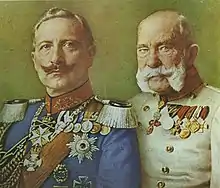Kaiser-Walzer
Kaiser-Walzer, Op. 437 (Emperor Waltz) is a waltz composed by Johann Strauss II in 1889. The waltz was originally titled Hand in Hand and was intended as a toast made in August of that year by Emperor of Austria Franz Joseph I on the occasion of his visit to the German Emperor Wilhelm II where it was symbolic as a 'toast of friendship' extended by Austria-Hungary to the German Empire.

Strauss' publisher, Fritz Simrock, suggested the title Kaiser-Walzer since the title could allude to either monarch, and thus satisfy the vanity of both rulers. The waltz was first performed in Berlin on 21 October 1889. The original cover of the piano edition bore the illustration of the Austrian Imperial Crown.
Composition
A quiet march starts the waltz's introduction before a sweeping crescendo heralds the gentle principal melody of the first waltz. As more waltz sections are introduced, the mood remains constantly upbeat and triumphant. A cello solo near the end of the work reprises the melody of the first waltz section, before a trumpet fanfare ushers the end of the work, complete with a drumroll on the timpani and a strong brass flourish.
- Waltz 2
References
Based on original text by Peter Kemp, The Johann Strauss Society of Great Britain. Used with permission.
External links
- Kaiser-Walzer: Scores at the International Music Score Library Project